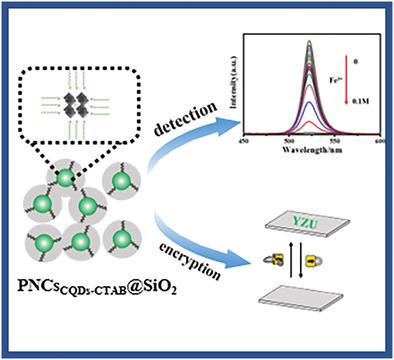当前位置:
X-MOL 学术
›
Adv. Mater. Interfaces
›
论文详情
Our official English website, www.x-mol.net, welcomes your feedback! (Note: you will need to create a separate account there.)
Internal–External Stabilization Strategies Enable Ultrastable and Highly Luminescent CsPbBr3 Perovskite Nanocrystals for Aqueous Fe3+ Detection and Information Encryption
Advanced Materials Interfaces ( IF 5.4 ) Pub Date : 2021-09-08 , DOI: 10.1002/admi.202100588 Jie Guan 1 , Ying‐zhuo Shen 1 , Yun Shu 1 , Dangqin Jin 1, 2 , Qin Xu 1 , Xiao‐Ya Hu 1
Advanced Materials Interfaces ( IF 5.4 ) Pub Date : 2021-09-08 , DOI: 10.1002/admi.202100588 Jie Guan 1 , Ying‐zhuo Shen 1 , Yun Shu 1 , Dangqin Jin 1, 2 , Qin Xu 1 , Xiao‐Ya Hu 1
Affiliation

|
The high photoluminescence quantum yield (PLQY) of perovskite nanocrystals (PNCs) makes them promising candidates in optoelectronics. However, the easy loss of structural integrity and fast chemical degradation upon exposure to moisture influence their reliable applications in aqueous solutions. Here, a hierarchical surface construction strategy is rationally designed to fulfill an internal–external stabilization of PNCs. Carbon quantum dots (CQDs) and cetyltrimethyl ammonium bromide (CTAB) have been demonstrated stabilized PNCs internally by eliminating the proton transfer-induced ligand desorption. Meanwhile, CTAB acts as a cationic surfactant in consolidating the subsequent SiO2 coating to prevent the PNCs from external environments. Based on the resulted PNCs, a sensitive and selective fluorescence film sensor for Fe3+ detection is successfully constructed. The fluorescence of PNCs at 525 nm is quenched after the addition of Fe3+ in the concentration range from 770 pm to 411 µm. As Fe3+ ions attached to the surface of the film are removed with water, the fluorescence of the film can be easily recovered. Owing to this character, the application of the PNCs toward the confidential information encryption has been proved. This work provides an effective design strategy to improve the stability of PNCs and extends their applications in sensing and encryption areas.
中文翻译:

内部-外部稳定策略使超稳定和高度发光的 CsPbBr3 钙钛矿纳米晶体用于 Fe3+ 检测和信息加密
钙钛矿纳米晶体 (PNC) 的高光致发光量子产率 (PLQY) 使它们成为光电子学中的有希望的候选者。然而,暴露于水分后结构完整性的容易丧失和快速的化学降解影响了它们在水溶液中的可靠应用。在这里,合理设计了分层表面构建策略来实现 PNC 的内部-外部稳定。碳量子点 (CQD) 和十六烷基三甲基溴化铵 (CTAB) 已通过消除质子转移诱导的配体解吸在内部证明是稳定的 PNC。同时,CTAB 作为阳离子表面活性剂在固结后续的 SiO 2涂层以防止 PNC 受到外部环境的影响。基于得到的PNCs,成功构建了用于Fe 3+检测的灵敏且选择性的荧光薄膜传感器。添加浓度范围为 770 p m至 411 µ m的 Fe 3+后,PNC 在 525 nm 处的荧光被淬灭。由于附着在薄膜表面的Fe 3+离子被水去除,薄膜的荧光可以很容易地恢复。由于这一特点,证明了PNCs在机密信息加密中的应用。这项工作提供了一种有效的设计策略,以提高 PNC 的稳定性并扩展其在传感和加密领域的应用。
更新日期:2021-10-08
中文翻译:

内部-外部稳定策略使超稳定和高度发光的 CsPbBr3 钙钛矿纳米晶体用于 Fe3+ 检测和信息加密
钙钛矿纳米晶体 (PNC) 的高光致发光量子产率 (PLQY) 使它们成为光电子学中的有希望的候选者。然而,暴露于水分后结构完整性的容易丧失和快速的化学降解影响了它们在水溶液中的可靠应用。在这里,合理设计了分层表面构建策略来实现 PNC 的内部-外部稳定。碳量子点 (CQD) 和十六烷基三甲基溴化铵 (CTAB) 已通过消除质子转移诱导的配体解吸在内部证明是稳定的 PNC。同时,CTAB 作为阳离子表面活性剂在固结后续的 SiO 2涂层以防止 PNC 受到外部环境的影响。基于得到的PNCs,成功构建了用于Fe 3+检测的灵敏且选择性的荧光薄膜传感器。添加浓度范围为 770 p m至 411 µ m的 Fe 3+后,PNC 在 525 nm 处的荧光被淬灭。由于附着在薄膜表面的Fe 3+离子被水去除,薄膜的荧光可以很容易地恢复。由于这一特点,证明了PNCs在机密信息加密中的应用。这项工作提供了一种有效的设计策略,以提高 PNC 的稳定性并扩展其在传感和加密领域的应用。



























 京公网安备 11010802027423号
京公网安备 11010802027423号